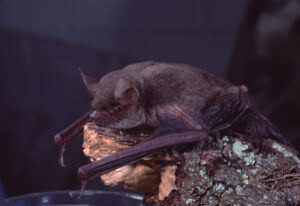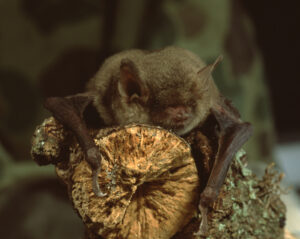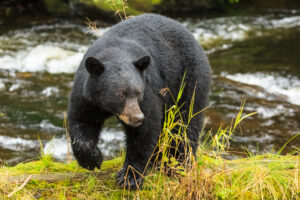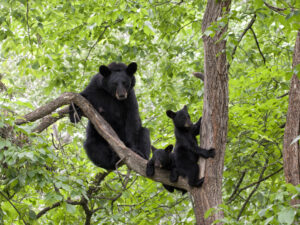Over the past month, the Northwoods Wildlife Center has been discussing the first signs of spring, and today, we would like to conclude with the first signs of spring in the mammalian world. Sure, there are many mammals, such as squirrels and foxes, that we see on and off again throughout the winter, but what about the mammals that choose to slumber during this time? The little brown bat and the American black bear are two mammals that sleep away the winter months and are a sure sign that spring is officially here to stay once they awaken.
Little Brown Bat:
Little brown bats are small, nocturnal insectivores ranging between 2 1/2 to 4 inches long and have a wingspan between 8 and 11 inches. They have glossy fur in various shades of brown, with the fur on their bellies being lighter. Not only are they one of the eight species of bats found in Wisconsin, but they can be found throughout the northern United States and into Canada, as well as in the forests of Mexico. In contrast, they are not as prevalent in the southern states and are non-existent in the Great Plains. During the months that they are active, one little brown bat can consume up to 1,000 insects in an hour, and prior to hibernation, they will eat enough insects to gain 30% more body fat to prepare themselves for their deep slumber.

Besides gorging on insects in the fall to prepare for hibernation, mating season is also underway. However, instead of the female becoming pregnant right away, she will store the male’s sperm until the spring, becoming pregnant several months after mating has occurred. Once the mating season is over and the temperatures begin to drop, little brown bats make their way to their hibernaculum (a shelter occupied by a dormant animal), sometimes traveling up to 300 miles to reach their destination. Limestone caves and mines are an ideal hibernaculum for little brown bats because the temperatures are above freezing, the humidity is high, and since they are non-territorial, these locations allow hundreds, if not thousands, of bats to hibernate together.
Once little brown bats reach their winter roosting sites, hibernation kicks in. Their heartbeat drops from roughly 200 beats per minute to 8 beats per minute, and their body temperature can drop to near freezing. While in hibernation, little brown bats can conserve 98% of their energy costs. In Wisconsin, little brown bats have been known to hibernate for as long as six months and typically begin to awaken at the end of March to mid-April.
Females are the first to emerge from the hibernaculum as they are now expecting and need to make their way, at roughly 12 miles per hour, to their nursery roost, which they share with other females. The females will give birth to one pup in May or June and are the sole caretakers of the young. Meanwhile, while females head to their nursery roost, males return to their summertime roosts. During this migration back to their summer and nursery roosts, you can often see them fluttering about in the night sky, searching for insects, satisfying their hunger after months of not eating.

Although females spend most of their “down” time in the nursery roost, little brown bats have more than one roosting location during the summertime: a night roost and a day roost. Ideal roosting sites include abandoned buildings, caves, trees, rocks, and wood piles. Since they are nocturnal, little to no light penetrates their daytime roost, and nighttime roosts provide a resting location after hours of hunting for insects.
Although many people view little brown bats and other species of bats as a nuisance or even scary, little brown bats play a vital role in disease control and naturally reducing unwanted insect populations. From the moment they emerge from hibernation in the spring until they start hibernation again in the winter, they constantly consume insects such as Wisconsin’s other state “bird,” the mosquito. By consuming hundreds of mosquitos an hour, diseases such as West Nile and Malaria are not as big of a threat as they could be if bats were not around. Besides keeping certain diseases at bay, farmers with large populations of bats in their area can reduce the amount of pesticides they use. All in all, we as humans benefit from little brown bats, so the next time you see a little brown bat fluttering about, try not to be fearful but rather thankful for their presence.
American Black Bear:
The American black bear is found in most of North America, Canada, and parts of Mexico. Although they have the color black in their name, this can be misleading due to their different colorations. They can be black, brown, cinnamon, blue-gray, blonde, or white. This coloration coincides with the environment they live in. In warmer climates, black bears tend to be lighter in color to help reduce retaining heat on hot days, and in colder temperatures, they are darker in color, making it easier for them to absorb the warmth from the sun’s rays.

In Wisconsin, the American black bear’s colorations are black and dark brown. Females typically weigh between 120 and 180 pounds, and males weigh between 250 and 350 pounds, with some reaching up to 700 pounds. They mainly feed on grasses, plants, and fruits, and their primary protein sources are nuts and insects such as beetles and termites. Black bears have been known to eat carrion and smaller mammals, and black bears that are further north also indulge in a salmon feast during spawning season. The American black bear is typically a solitary animal, except when they mate in June and when females are with their young for the first year of their lives.
To understand why the American black bear is a first sign of spring, or more so, a definitive sign that spring is here to stay in the mammal world, let’s discuss what it undergoes during the winter. The American black bear goes through quite the process of surviving the winter months. In the fall, males and females must consume four times more than their average calorie intake of 5,000 calories a day, to roughly 20,000 calories a day. Black bears become more nocturnal in October and November and begin looking for an ideal den to slumber in. American black bear dens can be in rock crevices, caves, standing hollow trees, or they dig into hillsides or under the root systems of trees. Due to not being “true hibernators,” because they can wake up from time to time, they go into a state of torpor, and more often than not, they pick more than one den location due to the possibility of being disturbed.
Once black bears hunker down for the winter and begin their winter slumber, their heart rates drop from 50 beats per minute to 8-10 beats per minute, and their breathing drops from 15 to 20 breaths per minute to roughly one breath every 45 seconds. While in hibernation, they lose about half of their body fat, use up to 4,000 calories daily, and do not eat, drink, defecate, or urinate. Although deep in sleep during the winter, researchers have recorded that bears in “hibernation” are still alert to their surroundings. In one study, researchers were able to monitor black bears for an entire year. They found that when they approached the den of a sleeping bear, their heart rates would go up and stay up for several days after the fact. Even though the American black bear’s body changes while sleeping the winter months away, female black bears undergo an even more elaborate and challenging process during the winter months.
Similar to the little brown bat, although mating occurs in June, the female does not immediately become pregnant. Instead, she undergoes delayed implantation, in which the embryo does not attach to the uterus until the fall. The female will not become pregnant if she does not store enough fat reserves for the winter. If she does become pregnant, a malnourished female’s body will either absorb the embryo, give birth to a stillborn, or the cub(s) will die due to lack of milk. According to a study conducted in Minnesota, for a female to have a successful pregnancy, they have to be at a certain weight by winter. This study showed that females who weighed more than 176 pounds before hibernation had a 93% success rate with their litters; females who weighed less than 176 pounds had 43% of their cubs die, and several females did not give birth at all.

Females with a successful pregnancy will wake up during torpor to give birth to their young and doze off and on for the rest of the winter, waking up when the cubs cry out. Before giving birth, the female’s heart rate drops deeply at the beginning of hibernation and increases the closer she gets to giving birth. After giving birth, her heart rate will fall again, and she will change positions less frequently while sleeping compared to the beginning of hibernation prior to giving birth. To maintain a good weight and provide the nutrients needed for the young, after she has given birth, she will consume her young’s feces and urine.
Typically, as the snow begins to melt in April and temperatures rise, American black bears begin to leave their dens. Adult males are the first to leave their dens, followed shortly after by females and their cubs. Due to their later emergence in the spring, the American black bear is a sure sign that spring is officially here to stay.
Thank you to the following sources for the information for this post:
Signs of Spring: Report Your Observations! (journeynorth.org)
https://www.ontarioparks.ca/parksblog/bears-hibernation/
https://www.treehugger.com/surprising-facts-about-black-bears-4864512
https://royalpurplenews.com/36446/state/backhome/bears-awaking-a-sign-of-spring/
Fast asleep to wide awake: Hibernating bears, predation and pregnancy | ScienceDaily
When Do Bats Come Out of Hibernation? (getbatsout.com)
Species spotlight: Little brown bat | Mass.gov
C:\Users\redelj\AppData\Local\Temp\mso90A5.tmp (wiatri.net)
https://www.ontarioparks.ca/parksblog/bears-hibernation/
https://www.treehugger.com/surprising-facts-about-black-bears-4864512
https://royalpurplenews.com/36446/state/backhome/bears-awaking-a-sign-of-spring/
Fast asleep to wide awake: Hibernating bears, predation and pregnancy | ScienceDaily

